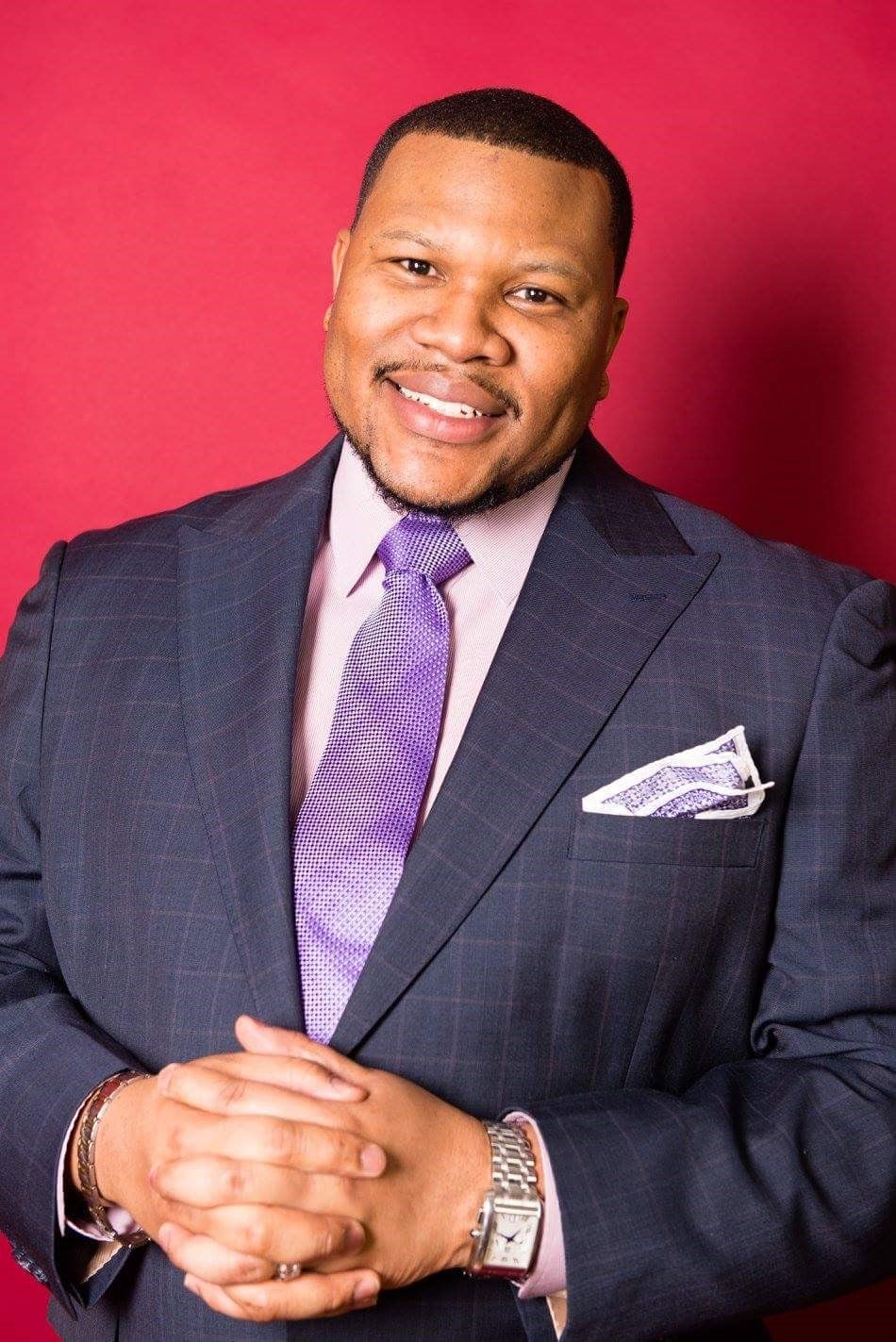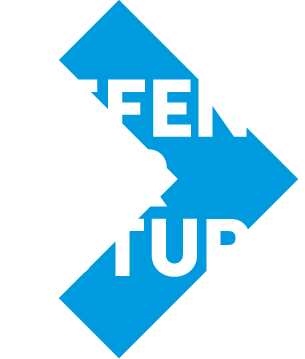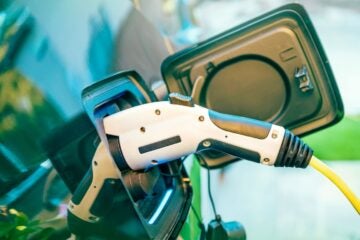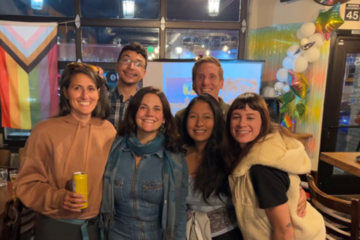For Black History Month, we spoke with Pastor Ezra Tillman of the First Trinity Baptist Church in Flint, Michigan, to discuss the Flint water crisis, the intersection of faith and advocacy and environmental justice.
Can you share a little bit about yourself – where you grew up and how you ended up in Flint at First Trinity?
I am a native of Detroit, Michigan. I spent my formative years in Detroit public schools. When I entered middle school, I transferred to Ferndale School District, it was there I graduated from High School. I played sports and secured a scholarship to Henry Ford Community College. After graduation, I enrolled in St. Mary’s College.
It was during that time I accepted my call to preach. I attended a local Seminary, and my Preaching Ministry began. I was reacquainted with my wife to be (we went to high school together). After marriage, we settled down in Metro-Detroit, I held different positions in the Ministry of other churches, and we began to raise a family. During this time, I received a call to Pastor a church in Ohio, I accepted the call and commuted for a few months, before relocating to Ohio. I was there when I received a call to come and preach as a Pastoral Candidate for First Trinity Missionary Baptist Church. I was offered the position and I accepted. It was one of those things where timing and fate lined up. I just happened to get called to this church in the same week the Flint water crisis began, unknowingly during that time, the water was switched over (to the Flint River) in April of 2014.
As a leader of faith, how have you been advocating for issues that intersect with environmental justice and your community? And how has First Trinity Missionary Baptist Church been involved in your efforts?
As a preventive measure of disease and the quality of life, President Clinton signed the EJ Executive Order in 1994. Environmental justice (EJ) is the fair treatment and meaningful involvement of all people regardless of race, color, national origin, or income with respect to the development, implementation and enforcement of environmental laws, regulations, and policies. It includes the Safe Drinking Water Act and Clean Water Act of 1972. This correlation has a direct effect on Social Justice. These laws were established to protect the quality of all drinking water in the United States and focus on all water designed for drinking use whether from an underground or above source. The public health and quality of life for Flint residents were compromised before and after the water crisis.
Our approach to advocacy started with service, and during the time of the water crisis, which has been an ongoing, local issue – yet was one that had not made the news. For about a year-and-a-half beginning in 2014, the water crisis did not receive much attention. A Pediatrician was concerned about the lead levels she saw in children and began to disclose her findings, but to no avail. The crisis was made public to the people of Flint, and the nation, with the election of a new mayor in Flint. She chose to take a bold approach and labeled the tainted water; a water crisis and declared an emergency. In doing so, the mayor also drew the attention of Rachel Maddow, who has ensured that the Flint water crisis – and other local issues – remained at the forefront of a national conversation. A local ministry (Mission of Hope) at the time was servicing the community by providing services to the homeless, the mentally ill, and other at-risk members of the community. He was begging for water from the community and was being ignored. I happened to watch the show one night and it pricked my heart, it was an emotional conviction to respond and do the right thing. The people of Flint were begging for a basic human need, clean water.
The City of Flint began giving out vouchers because they knew there was a water crisis. Anyone could see that the tainted water – the color – was not healthy, and what it would do to clothes washed in the water. It was late 2015 that the governor finally responded because of the national attention they got from Rachel Maddow. I realized as a Pastor at the local level, it was a matter of pastoring people, doing what we know. Our faith requires us to be the hands of Christ, to be the feet for Christ. We are servants of the Lord, so we serve. I did not know then, that taking that position and standing in proxy would touch the hearts of others, get their attention, and give them a place to do their part as well. When we stood in that place, we served as a conduit from people to people, and it started a national movement in Black America through mission groups and conventions.
That was the initiative, and It was church based at the time, we financed the project. Once I got First Trinity informed and organized to distribute bottled water, my wife and I spread the word of the water crisis by word of mouth and social media. We became the “water hub” of Flint, donations and contributions began to pour in from other churches, organizations, and people locally and across the nation by organizing in their neighborhoods and churches. People from Atlanta, Chicago, Georgia, and Florida, to name a few, would drive to Flint with truckloads of water. The church water distribution site moved to a larger scale. We had to find warehouses, the fellowship hall and garage was full. We eventually ended up having to rent two truck trailers to secure extra space as people continued to send in clean water by the truck loads. The amount of bottle water was so plentiful, we had to find places to put it and secure pallet jacks, and high lifts to get the water out of the trucks. The distribution site was moved to the church’s annex.
Some donations, from other cities, unaware of First Trinity procedure to receive the donations, would drop water on street corners. Some people thought we were wasting water when they saw bottled water rolling down the street. But the truth of the matter is that these were neighborhoods with no homes, so that water was not getting to the people who needed it. We sought to correct the mistake. This was a rebirthing for our church, with the mobilization of what mission looks like. We had the men coming to church on Sunday morning, bringing in overalls and back braces and we had eighteen-wheelers pull up in the alley to drop off water. Our Deacon Wives, Mission Ministry, and ladies of the church assisted with this as well. We started putting together care packages of baby wipes and hand sanitizer. This was our second stage in distributions, trying to serve our community.
We have been able to do this for a while – five, six years of serving. Ninety percent of the church are retirees, but they rolled their sleeves up and responded to what we knew to be right. Our actions became an opportunity to be a voice. News outlets began to see our church as a place for grassroots action, a place of an oasis for residents, where we are involved in quite a few different things. Then we got an opportunity to start speaking to not only the water crisis issue, but also what’s behind it. What are the structures that have allowed these things to impact our community? That has been the general platform from service to advocacy.
The Movement for Black Lives saw a resurgence of activity and support following the murders of Breanna Taylor and George Floyd, but we know that violence against black lives is nothing new. Violence against black lives with regards to America stretches back to our nation’s founding. We saw many environmental groups respond to this reckoning in different ways. How do you think the environmental movement is doing when it comes to facing this reckoning of racial injustice, nine months later?
I think that the environmental movement has been allowed to reflect on these issues. It is clear, previously, black, and brown communities have not had the opportunities to be at the forefront of this conversation, so I applaud the environmental movement for taking steps to address the inequality within the movement. The work, however, continues in addressing the structures that have been placed in our communities. And I am grateful to be part of that and to speak to it because this is a systemic structure.
This is not a mishap, this is not a mistake, this is something that was designed. This is systemic racism. This is environmental racism. It is the plan of redlining communities to intentionally put industrial areas next to neighborhoods with our children, to restructure areas in which garbage dumps are being turned into places for housing. And it is no surprise in our community that we are susceptible to so many diseases and we have so many other issues. This is the design and plan for how to make ghettos and how to control a population in those areas.
We recently saw the recent vote in the Senate and how senators responded to the insurrection in January. What we saw was complacency, and how the structure, as it pertains not to seeing color. This is another insult that you often hear, that, “I don’t see color.” Well, you cannot miss what you see now going on in our government because you must see color. If those who participated in the insurrection were of another skin color, they would not see the light of day. It is another clear picture of the true heart, lacking compassion from those who are hiding behind the American flag.
The environmental movement should continue pushing the needle while it has the opportunity. We all know that the cameras are pointing to whatever is the next biggest story. We are working toward educating people within our communities of the importance of addressing and speaking up and supporting people who are advocating for our issues – about our health, about our hope, about the future of our children, and about taking care and providing resources for the elderly. Our neighborhoods lack the stores that will provide actual quality produce. We do not have the resources, programming, and funding to support eradicating these problems for those particular people that we often have compassion for. As we push the needle on policy, I think that will be the goal, because if you do not change the structure, throwing money at an issue does not fix it. This has been my experience; when the government can show on their balance sheet, they have sent so many millions of dollars towards a project, it is perceived as if they have eradicated the problem and that is enough. It is never enough when the structure in place is designed to operate the way it is. So, as we move forward and we speak about green issues – things like solar power, we need to speak about how these solutions will help transform and change the structures in our communities for the better.
President Biden has pledged to center environmental justice across his administration and the work the federal government does – including the EPA, Department of Transportation, and Department of the Interior. We saw his executive orders and are also seeing Congress pursuing legislative solutions on climate and clean energy. While these are encouraging pieces of news, what more do you hope our leaders focus on, especially when it comes to addressing local challenges like the Flint water crisis and the recovery from COVID19?
I am hoping that our president, who has presented himself to be a believer, and as a person of faith who has throughout the years experienced many tragedies throughout major events in his own life, would consider others who are overwhelmed, will persevere. I hope that he will do as the Scripture says and to “love your neighbor as yourself.” In doing so through faith, and by principle, he is doing that which we are asking. We are not asking for anything that would not be owed – we want to make sure that the playing field is made even, we are asking for equality. We are asking why on one side of the street the grass is watered, while on the other side sits abandoned cars and homes. These issues are not being addressed, as if they are not a hazard to our communities when it is clear they are.
I think that the president has taken the approach to address many of the injustices, so that more people can achieve the true American dream. The president can address these disparities and discriminations in our communities, whether it is education, our health, or our environment. Whatever the case may be, if the president does not seize this opportunity, he will be letting down the hopes of many who believe in what American stands for. We cannot return to the same vicious cycle of the past. So, I think as he starts his administration, if he continues to enact policies that address these issues, then we can begin to see the America we all hope and dream for.
How do you see faith communities, particularly those of color, continuing to engage with our elected leaders on the important issues of our time?
I would address this from the perspective of the Black church because they have always served as a backbone in our communities. The church has been a place of resources and information, and a place for training when we lack traditional support like that from the government. For many communities across this country, churches have opened their doors. In Flint, our church has opened its doors to people to receive vaccinations, to make sure people have access to fresh produce, and to those who cannot afford medicine or have lost their jobs.
When it comes to advocacy, it is not just in getting in front of the microphone, but it is also about providing opportunity – this has been our history; this has been the foundation and the reason our communities have survived. Not only should we use our platforms to educate, but also, we must use them to hold our leaders accountable, to speak as a prophetic voice, to speak truth to power about what is just and what is righteous. We cannot achieve results if we do not challenge the problems we face in our communities. If we continue navigating this safe space, we will leave our people and our communities in a place of trouble.
As we speak about social justice and the environmental movement, it is not a gospel message if we are not challenging the injustice in our communities. Jesus called Sadducees and Pharisees a “generation of vipers,” to make them aware of their shortcomings. There is a risk, compromising our position when we take photo ops with elected leaders like with our past president.
What advice can you offer young people who are organizing and demanding change?
I would say know who you are, spend time reflecting on your history, which gives more power to your voice and passion for why you are doing what you are doing. Make sure that you are fundamentally sound with information because passion misguided still becomes an echo. It is easy to detect someone who is simply loud from someone who is powerful. You know, sometimes we feel as if our generation, our time, our seasons are different than someone else’s. But right now, we are learning the social justice issues of our time – is in fact, our version of the civil rights movement of the 1960s. This is the continued struggle of the Niagara Movement; it is the continuum. It rebirths itself in new generations. It is a matter of whether you can align yourself to the previous movement for the same issues.
This is the most deceiving aspect of the issues we face today – this is nothing new, no issue in the Black community is not echoed from a century before. All you must do is pick up a book and read about the same issues, the same structures, the same plans, the same disadvantages from generation to generation. There have always been those who comply. There have always been those who challenged, and in some cases, we end up where we started. I would tell a young person that if you want to be effective, you must be sure of who you are. You must have a strong platform and foundation where you are coming from. And it’s important to work with other organizations out there that are fighting the same causes for social justice, like the NAACP.
How can people get involved with you and your work helping those still impacted by the water crisis in Flint? There are many people across the country, but they may not know the best way of supporting your work. How can people help?
People can get in touch with us by visiting our church’s website at www.firsttrinitychurch.org. One of our initiatives is the Water Box program, which is a collaboration with Jaden Smith’s organization, 501Cthree www.501cthree.org, which accepts donations that will provide clean water to communities in need. We have four of these Water Boxes in Flint. Another initiative I lead is the Revive Community Health Center www.revivechc.org, which provides services to Flint/Genesee County families with children diagnosed with Autism Spectrum disorder and other behavioral concerns. We are focusing on addressing the health disparities in our communities, particularly as it relates to children facing complications during and after birth.




